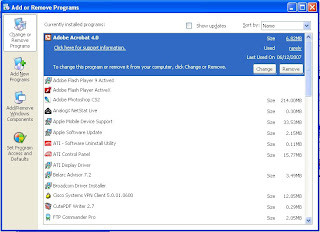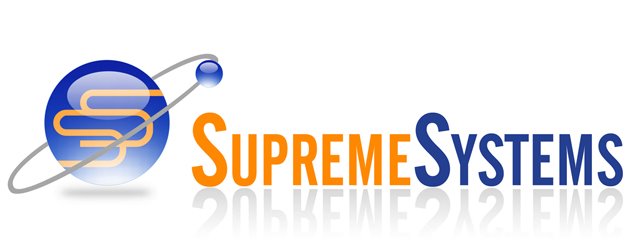By Angela Hart, Client Services Manager, Supreme Systems. You can contact Angela by email on angela.hart@supremesystems.co.uk or 0121 236 0065Like a car that needs regular servicing to ensure it is in tip top condition, your PCs also require regular attention and “health checks” I have listed what I consider the top ten ways you can make your PCs perform better. Some of these tips you can perform quite easily yourself, others you may need to use professional like
Supreme Systems (you knew there had to be a catch right?) to make sure you do not cause any damage to your PCs.
1. Delete all temporary files including internet cached files and cookies
For Internet Explorer 5 and above, you can follow these directions to delete all temp files and cookies.1) Open Internet Explorer and click on Tools
2) Click on Internet Options
3) On the General Tab, in the middle of the screen, click on Delete Files
4) You may also want to check the box "Delete all offline content"
5) Click on OK and wait for the hourglass icon to stop after it deletes the temporary internet files
6) You can now click on Delete Cookies and click OK to delete cookies that websites have placed on your hard drive.
To clear the history log:
1) Open Internet Explorer and click on Tools
2) Click on Internet Options
3) On the General Tab, in the middle of the screen, click on Clear History
4) Click OK
To clean up other temporary files
1) Click Start, Programs (or All Programs), Accessories, Systems Tools, Disk Cleanup
2) Choose the correct drive usually C:\
3) Check the boxes in the list and delete the files
2. Remove unused programs from you control panelThe easiest way I have found to simply remove unwanted programs is simply:
1. Go to
Start Control Panel and select
Add Or Remove Programs (see Figure 2).

Figure 2: Remove any software program with the Add Or Remove Programs utility under Control Panel.
1. Scroll down the list of the installed programs until you reach the program you want to uninstall. Select it and click the Change/Remove button. This will uninstall the program. You can install multiple programs using this option.
You can also use the disk clean up option outlined in top tip 1.
3. Remove old entries from windows registry
Now this is one of those tricky situations I mentioned earlier that you may need an expert to do for you as the registry is one of the most important areas of your computer. You can do this yourself manually but a small mistake could create huge problems for your PC. If you are a bit of a maverick and would like to try removing entries yourself, Microsoft has some great tips on how to do this.
I would recommend using Registry cleaners which the job automatically without any input from yourself. A good cleaner, one that I can recommend is RegCure (http://www.regcure.com/). You can get this for as little as £15 per licence and it works a treat. If you do not want to pay the £15, you can get a free scan which lists the Registry errors found and you could go and find these yourself but for £15 why bother?
If you have a good managed services provider such as Supreme Systems (hey…I am Sales Manager, the selling thing is in the blood) you should get this free as part of the service they provide. We conduct weekly Reg scans on behalf of our clients which are done each Friday between 12 – 1. The scans are done remotely and has little or no effect on our clients work day.
4. Clean out your Startup folder
Some programs will install themselves in your Windows Startup folder, which makes them run each time your system boots up. All you have to do is delete the menu shortcut, and they'll stop loading when Windows starts up. The programs will still remain installed on your system - they just won't run until you run them.
The easiest way to disable your startup programs is to use the MSCONFIG utility. Simply click on the Start menu and go to “Start/Run” and type msconfig” to access the utility.
Click on the ’startup’ tag to see all of the programs that run each time you start your computer. By examining their filenames and directories, you should be able to determine whether the program is necessary or not.
To be safe, don’t disable any program that you’re not sure about. Also be aware that several viruses, worms, and malware disguise themselves as legitimate Windows system file names.
Your next step is to go to the Start menu and click on Programs and then on Startup. This is the directory used by Windows XP to launch application shortcuts on boot-up. If you remove the shortcuts from this directory, the programs will not load on startup. Windows does not place critical files in this directory so there is much less chance of erasing an important file.
To the lay person this may seem pretty daunting. You may need the assistance of a well heeled IT expert for this.
5. Defrag your hard drive
Defrag (a new word I learnt only last week and have since used constantly – I like how it sounds and it is really a cool thing to do for your PC) is short for Defragment (another cool word).
One of the most important things you can do to speed up your PC is to defragment the hard drive. Over time, the data on your hard drive gets scattered. Disk fragmentation leads to slower PC performance, PC crashes, and slow startup and shutdown. Defragmenting your hard drive puts your data back into its proper place.
This makes it easier for Windows to access the data it needs to execute programs, thus speeding up your computer.
To Defrag your hard drive simply open the Run Dialog Box. In the Run dialog box, type dfrg.msc and click OK.
You can also access the Disk Defragmenter by clicking on the Windows Start Menu > Programs > Accessories > System Tools > Disk Defragmenter.
Couldn’t be easier!
6. Apply Windows Updates
I know this can be a pain (especially as in most cases you need to restart your PC for any change to take effect) but they are a necessary evil I am afraid. If you run Windows and you use the Internet you MUST stay up to date with the system patches that come out in response to the security exploits that are discovered on a weekly basis. Failure to update your system is an open invite to hackers who would like nothing more than to flood your computer with Malware designed to cause the most havoc!
You should get periodic prompts from your system asking you to scan for updates and do always say yes (I know it is a hassle but it really does work). You do not have to restart your computer immediately, you can opt to restart your PC later.
You can stay informed of the latest Windows Updates at: http://windowsupdate.microsoft.com/
7. Scan for Viruses & Check for Spyware and Adware
Viruses really are a nuisance and can bring your performance to a grinding halt. Running a regularly scheduled anti-virus program is one of the best ways to avoid problems and keep your computer running at optimum performance.
Spyware is software that allows companies to monitor what websites you visit. Some even allow the creator to access your computer. Adware is software that displays advertisements. Both of these use system resources and slow down your computer. Running a regularly scheduled anti-spyware and anti-adware program can help speed up you computer immensely.
8. Run Scan Disk
Windows provides a utility called scandisk. This program will fix errors caused by improper shut-downs, viruses, and other problems. Correcting these errors will help improve your system performance.
To run Scandisk, you first need to Open the Run Dialog Box. In the Run dialog box, type sfc /scannow and click OK.
Windows will now scan your hard disk for any problems in your system files.
9. Flush event logs
This is one for the experts I am afraid. Event logs simply record enables an application to publish, access, and process events. Event logs are set to a maximum size that determines how many entries each log can contain. When an event log is full, it will either stop recording entries or begin overwriting the oldest entries with new entries, depending on the log's settings in the Windows Event Viewer. In either case, you can clear the log of its existing entries to free the log and allow it to start recording events again. You must have Administrator rights to the computer on which the log resides in order to clear entries.
By default, the Application, System, and Security logs are set to a default maximum size of 4992 K. Custom logs are set to a default maximum of 512 K.
To clear an event log's contents from Server Explorer
1. Open Server Explorer, and then expand the node for the server on which the event log you want to clear resides.
2. Expand the Event Logs node. You will see a list of the three main event logs — Application, Security, and System.
3. Right-click the log node you want to clear, and then click Clear Event Log.
4. Click Yes when prompted to confirm the deletion.
You can also use the Windows Event Viewer to free up space on a log that has become full. You can set the log to overwrite existing events, you can write log entries to an external file, or you can increase the maximum size of the log. You cannot, however, remove only some of the entries in a log; when you clear a log, you remove all of its contents.
10. (Drum roll please!) Improve Swapfile (a.k.a. Pagefile) Performance
If you have more than 256MB of RAM this tweak will considerably improve your performance. It basically makes sure that your PC uses every last drop of memory (faster than swap file) before it starts using the swap file.
Go to Start then Run
Type “msconfig.exe” then ok
Click on the System.ini tab
Expand the 386enh tab by clicking on the plus sign
Click on new then in the blank box type”ConservativeSwapfileUsage=1″
Click OK
Restart PC
So there you have it – My top ten tips for improving the performance of your PC. If like many of our clients you are a busy business owner, you should consider outsourcing this function to a managed service provider. Health checks such as this come as standard and you have the peace of mind that IT is performing at its best.
To your success!
Angela
http://www.supremesystems.co.uk/



